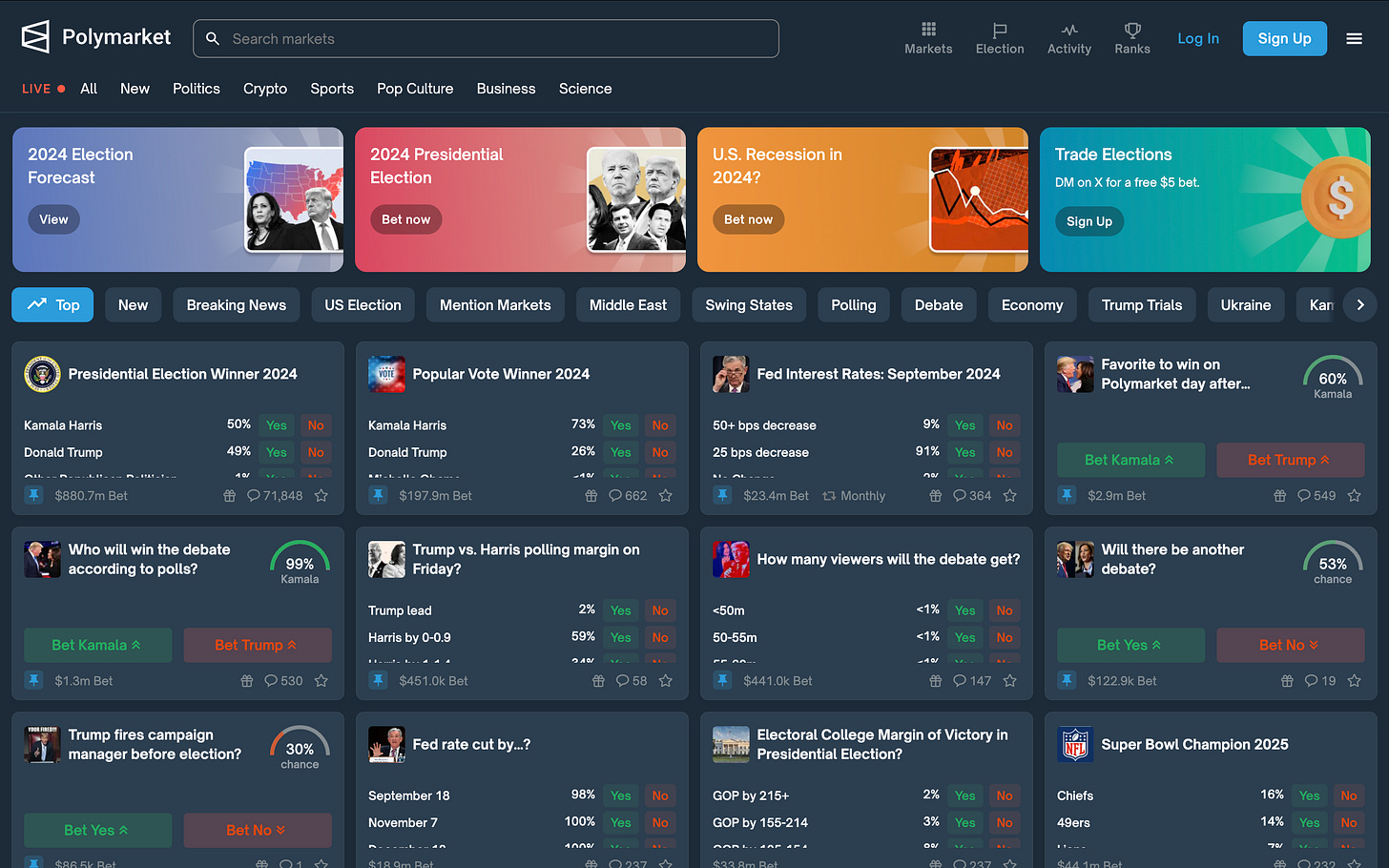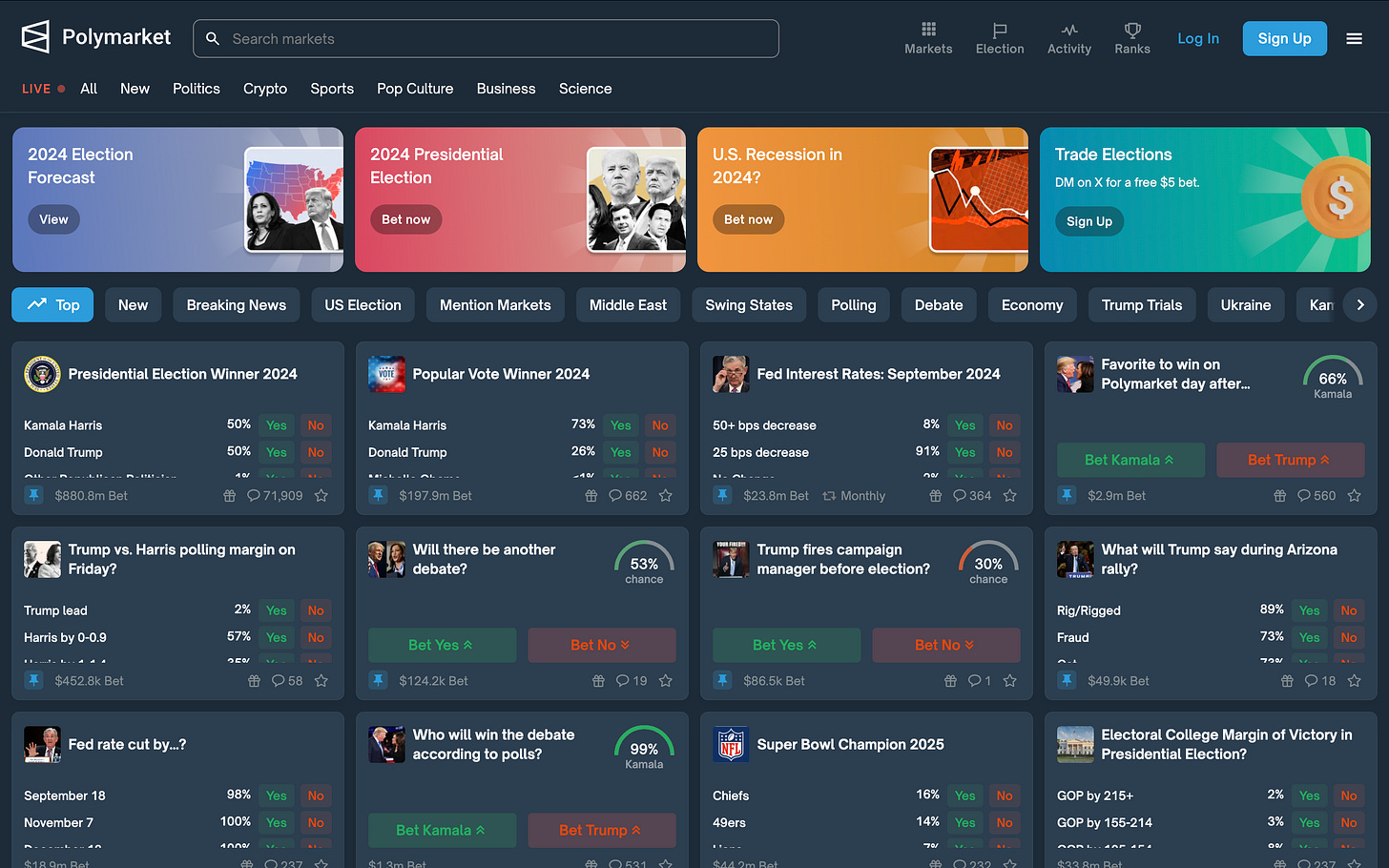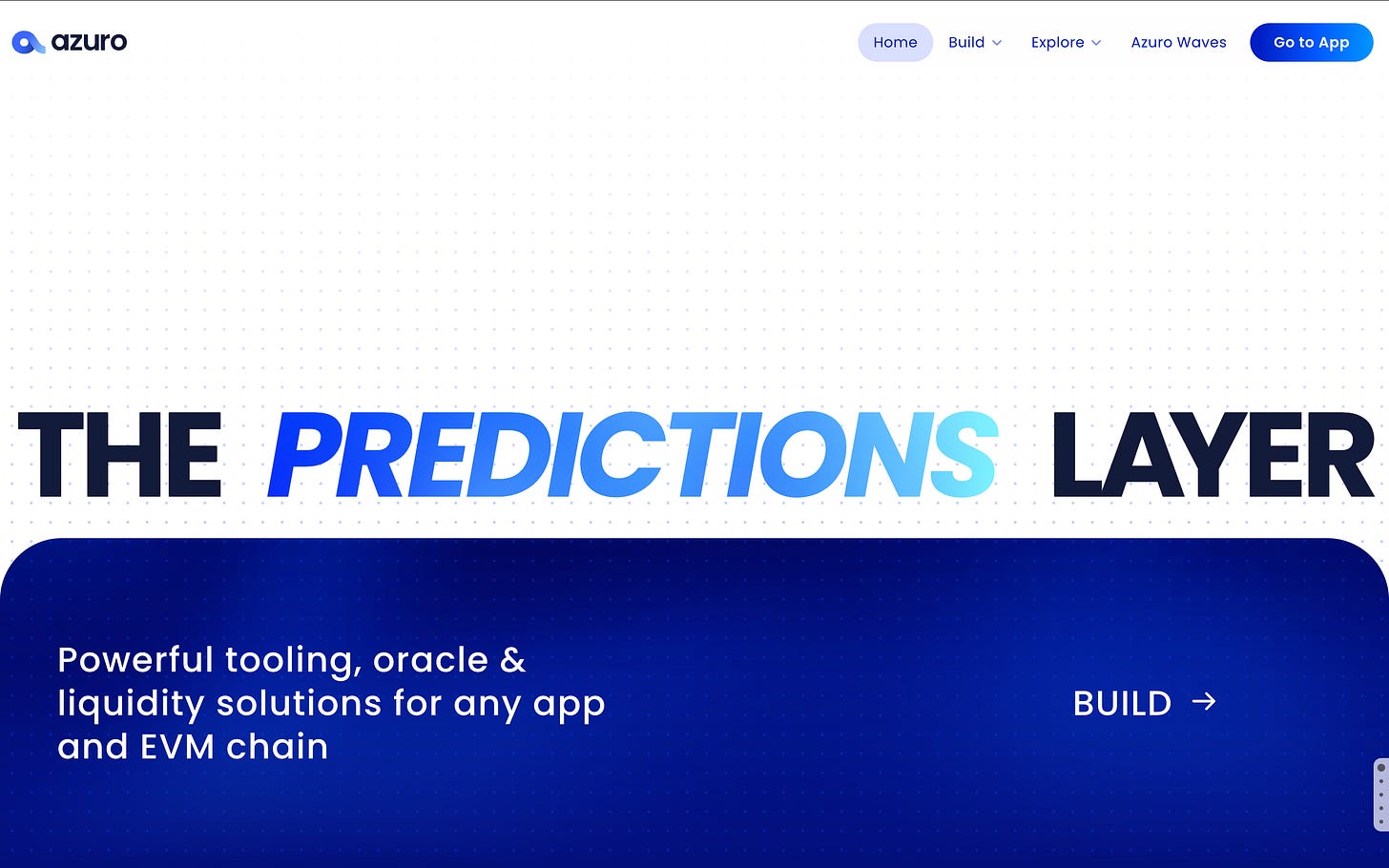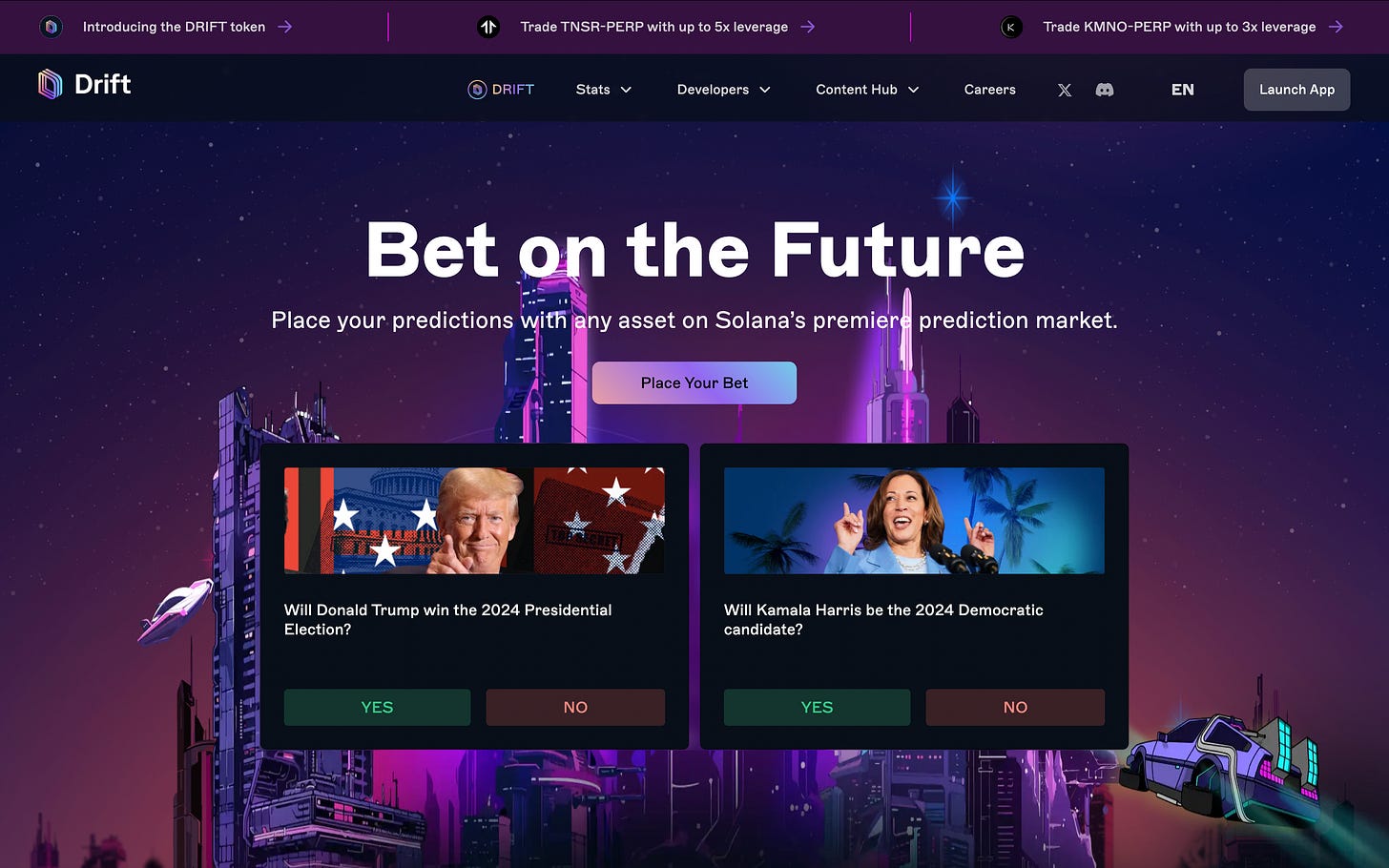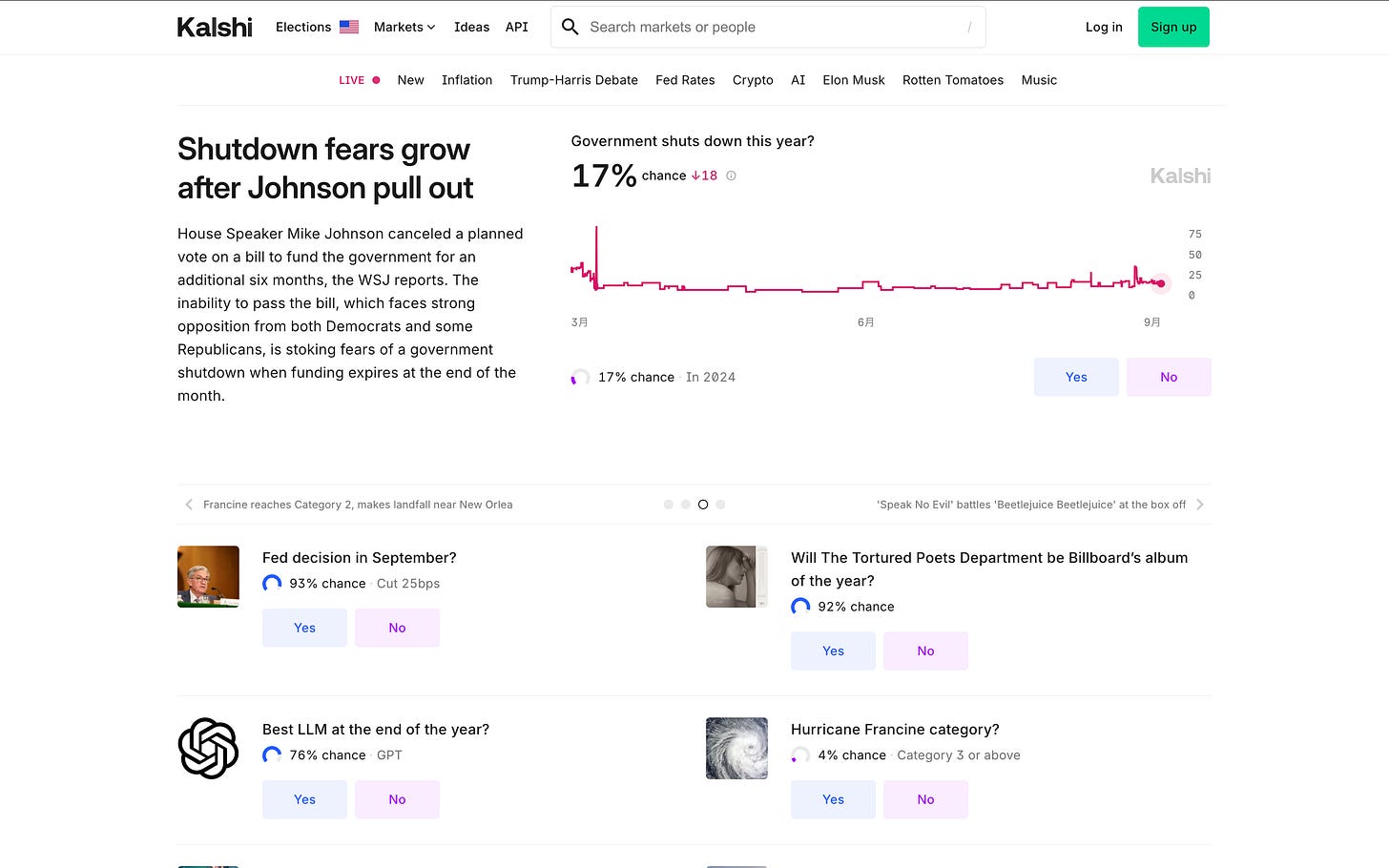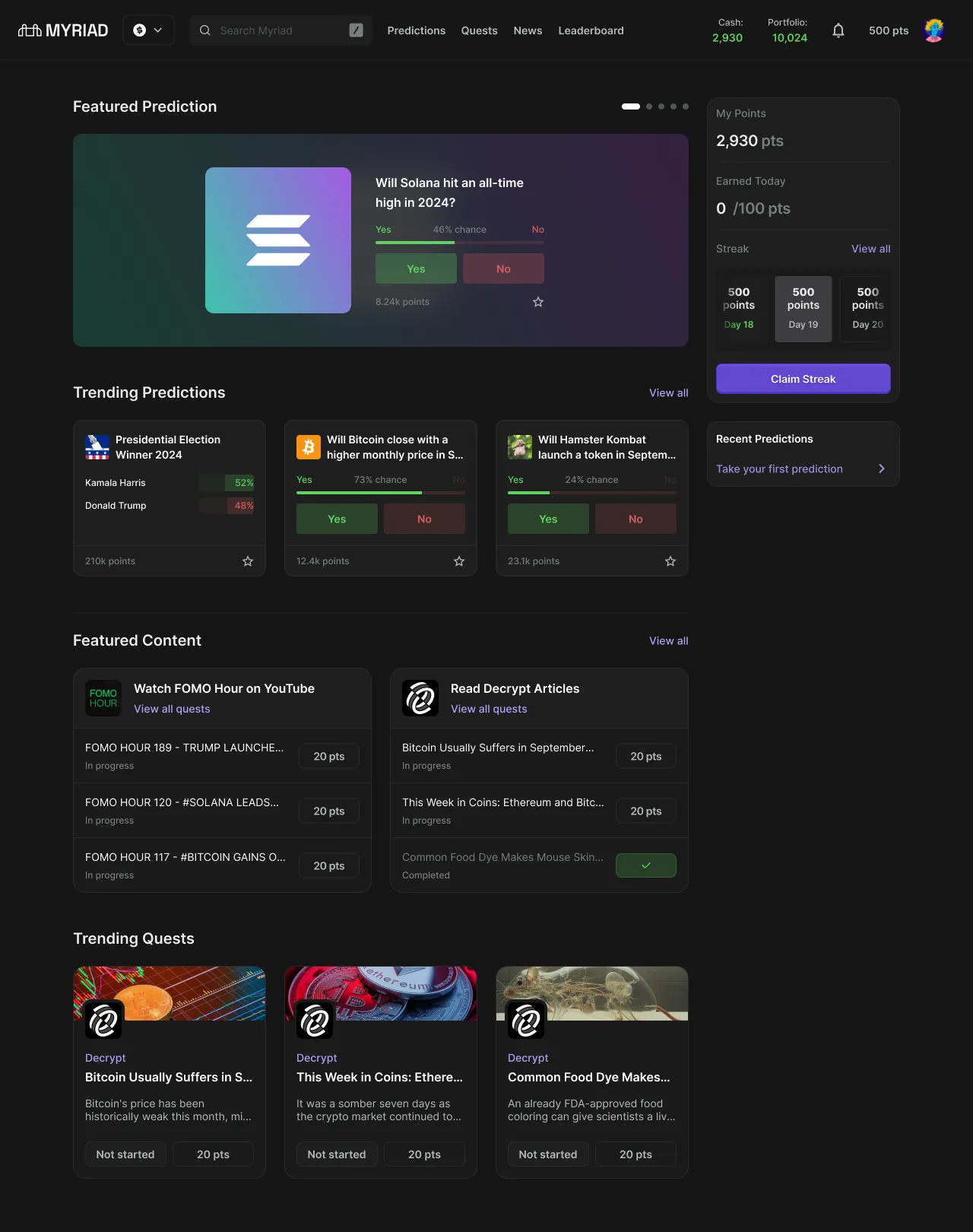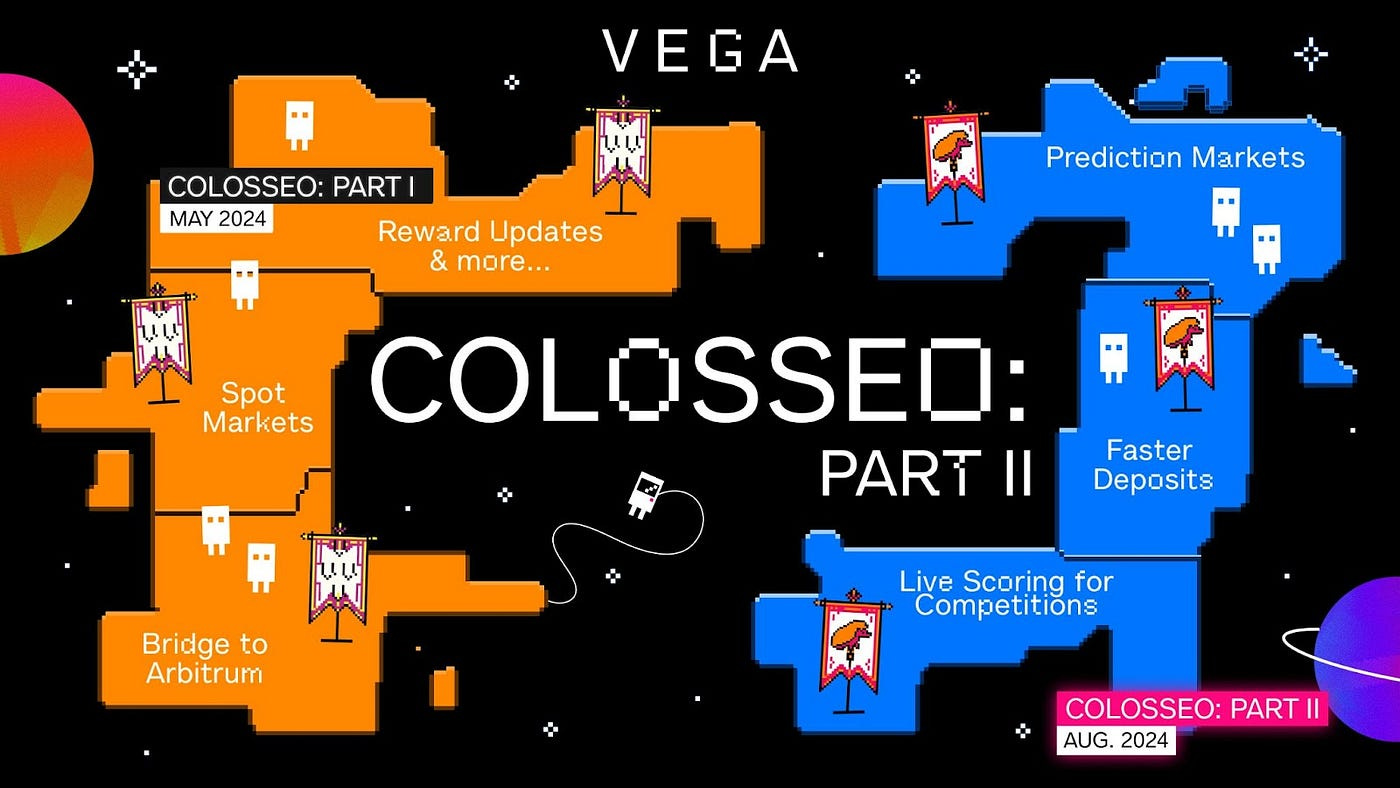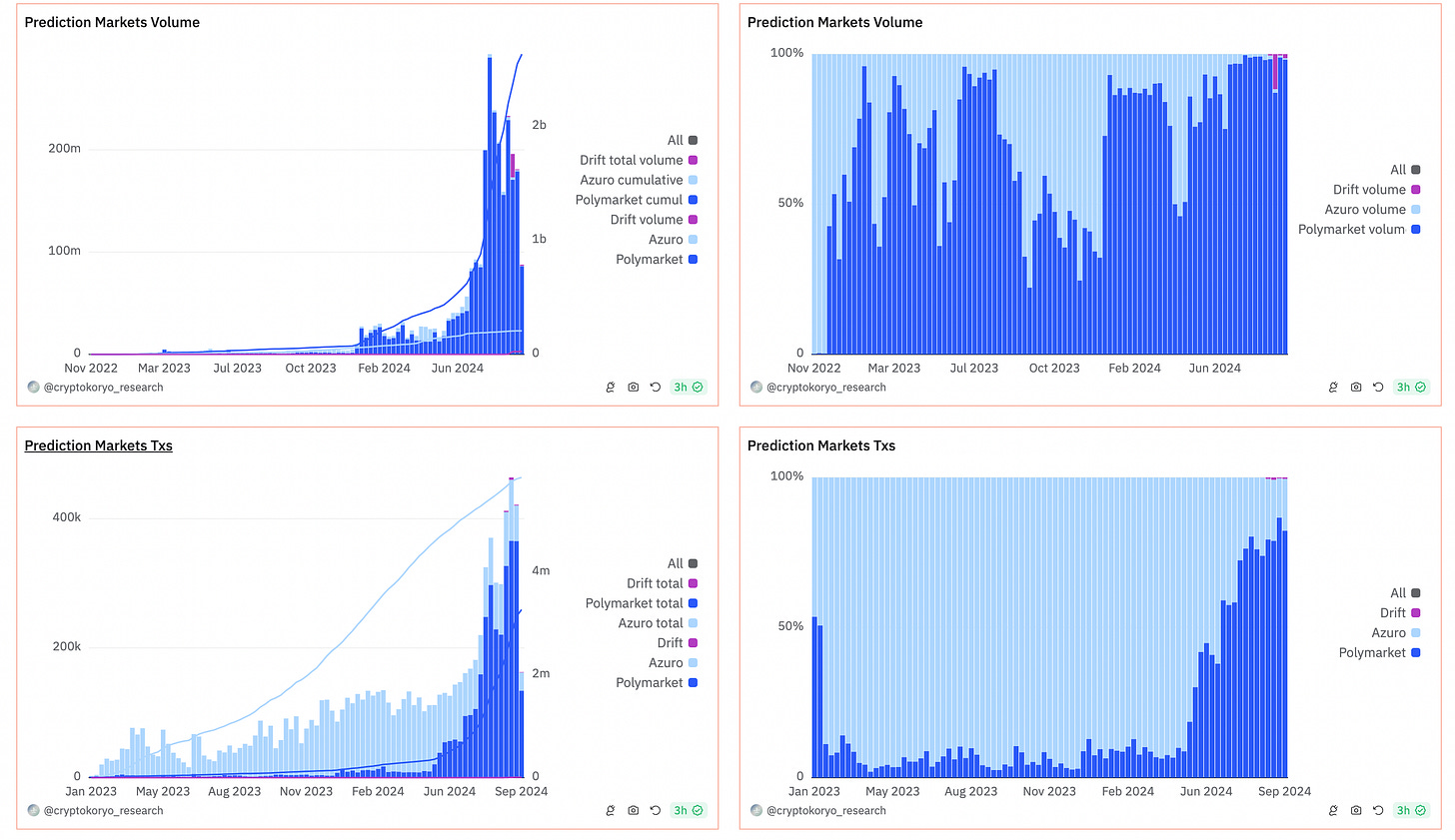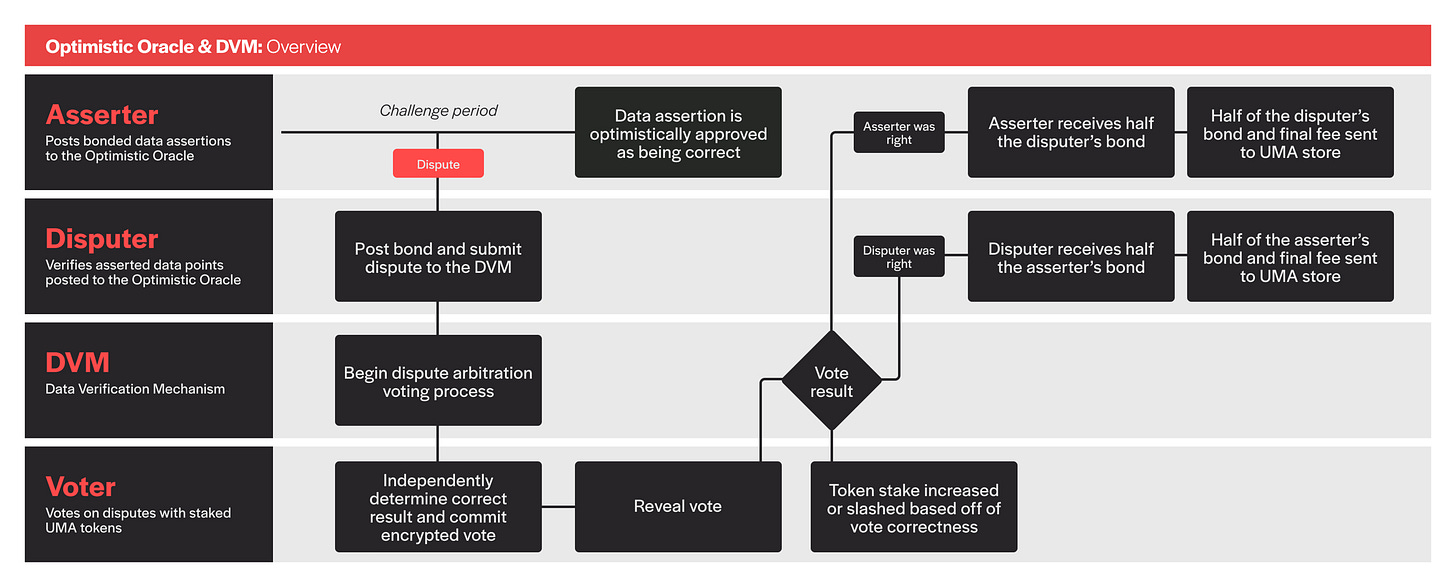Decentralized Forecasting Market Status, Challenges and Outlook
An overall view of the market and 10 specific players are also presented.
Good morning.
Mitsui from web3 researcher.
Today I will be writing a report titled "Distributed Forecasting Market: Current Status, Challenges and Prospects," in which I will take a deep look at Polymarket and other distributed forecasting market protocols that are making great strides, but are there any other players and what the future holds for the market in the first place.
📈What is the Distributed Forecasting Market?
⚙️Basic Elements of the Distributed Forecasting Market
✨10 Players in the Distributed Forecasting Market
💬The challenges and prospects of the distributed forecasting market
📈What is the Distributed Forecasting Market?
First, let me explain the term (market) "distributed forecasting market".However, since the "prediction market" existed in the first place and the web3-specific decentralized market has been added to it, we will explain the "prediction market.
A "prediction market" is exactly what it sounds like: a market that predicts whether or not a future event will occur.
The most obvious example is sports betting, where you predict the outcome of a sporting event, such as who will win the World Cup or who will win the gold medal at the Olympics, and bet on what you believe will happen.If you are correct, you get a return; if you are incorrect, you forfeit.
It may seem like a mere wager, but as many people bet, certain odds (multipliers) become visible, allowing us to predict future events with a certain degree of certainty.Of course, it is possible to be wrong, but it is definitely one of the factors that can be used to make a decision.
Here is an interesting story I found that illustrates the impact of this prediction market.
There is a discipline called "Superforecasting"Superforecasting" is a field of study.It is the study of analyzing and predicting the future in a variety of specialized areas and approaches, and a person who is particularly good at predicting the future in any field is called a "superforecaster".
The group Samotsveti, which is a group of forecasters who predict the future as such, is not a specialized researchDespite not being a team, they are highly targeted in a variety of fields.
Samotsveti won the 2020 and 2021 editions of the "Forecasters Competition," a competition in which contestants present difficult-to-predict future scenarios and compete for accuracy.The group of forecasters bet approximately $14,000 (about 2 million yen) on the possibility of a Russian invasion of Ukraine in 2022 and won $32,000 (about 4.4 million yen).
The participants in Samotsveti's meetings are researchers and experts in various genres and do not necessarily have expertise on the agenda.
But a studypublished in May 2022shows that "when making predictions about the future, aggregate non-expertopinions are a better guide to the future," or that "predictions for geopolitical events can be made closer to the truth by a group that aggregates using standard methods than by a group that has access to classified government information," the paper is often cited as saying that accurateSome believe that expertise is not necessary for accurate future predictions.
When Samotsveti produces good predictions, they are rarely based on facts that are not well known to others.As to why it can still produce more accurate predictions than other researchers and groups, Misha Yagudin, co-founder of Samotsveti, says, "The name Samotsveti means a semi-precious stone that is a gem but not a jewel, or a 'self-luminous/coloring' stone.This is a name that implies that forecasting is 'finding a good chunk of information.Even if we are not diamonds, by shining our self well, we can be great ones to shed light on the future," he said, intertwining the origin of the group.
What he means is, "There are groups (or disciplines that study them) in the world that can guess the future fairly accurately through group discussions" and that "that discussion does not necessarily have to be expert or have unique insider information"
This idea is exactly in line with the fundamental idea of the prediction market.It means that collective amateur forecasts boast a certain degree of accuracy.
And this forecast market, combined with web3 incentives and the accuracy and speed of transactions, is a decentralized forecast market.
⚙️ Basic Elements of a Decentralized Forecast Market
This is followed by a description of the basic elements of a decentralized forecasting market protocol.While there are some differences among protocols, the basic elements are the same.
We will use Polymarket as an example.
Here is the top screen, where bets (predictions) are being made on many future events.
The most exciting result is the outcome of the U.S. presidential election.Currently it is almost a close race, 50% vs. 49%.
You can bet either way from this screen, but here's the interesting thing about the decentralized prediction marketThe betting price matches the current %.
For example, if you want to bet on Trump to win in the above case, you can buy one unit starting at "49.4 cents"; buying 100 units costs "$49.4".If the result is incorrect, you forfeit your money, but if the result is correct, you get $1.00 per unit back.In this case, that means almost doubling your money.
And this trading of the number of units can be carried out even before the outcome.For example, suppose that an event occurs ahead that favors Trump and his winning percentage rises to 70%.In this case, the price per unit will be 70 cents, so if you sell your unit purchased at 49.4 cents, the difference will be your profit.This means that you can take a profit before the result.Of course, a reverse loss is also possible.
The basic structure of all protocols is in this form, and there are some differences here, such as the ability to trade futures and provide liquidity.
✨10 Decentralized Forecast Market Players
The following is a list of the current players in the distributed forecasting market, including Polymarket.The following is a list of current players in the decentralized forecasting market, including Polymarket.
1,Polymarket.
The most well-known and fastest growing, the world's largest decentralized forecasting market, launched in 2020 and residing on the Polygon chain.
2,Azuro.
Founded in 2014 and released in 2018 after an ICO in 2015, this is the earliest decentralized prediction market.It was initially released on Ethereum, but due to high gas prices, it moved to Polygon via an update called Augur Turbo.
*They seem to be rebranding quite a bit and are now the underlying protocol for creating on-chain forecast markets, rather than the forecast market itself.
3,Drift.
Drift, a DEX on Solana, added a predictive market function, BET, in August 2024.
4,Hedgehog Markets
A decentralized forecasting market that exists on Solana, released in 2023.It also offers a mobile app that allows users to create and answer a variety of surveys and earn tokens.
5,Kalshi
The only forecasting marketplace in the U.S. regulated by the CFTC.Although it does not use blockchain as its foundation, it also deals with crypto topics and receives support from Paradigm, a crypto VC.
6,Predict.
Distributed forecasting market on Blast, just released in September 2024.
7,Swipe.
A decentralized forecasting market on TON just announced for conception in September 2024.They are currently accepting registrations for the Waiting List and the forecast market will be available on the Telegram Mini App.
8,MYRIAD.
A prediction market and engagement ecosystem by Decrypt and DASTAN, the media company that is the parent company of Rug Radio.The company is considering a specification that would allow users to earn points by reading articles, etc.
9,Vega Protocol
Vega, the Cosmos-based perpetual futures platform also supported by Coinbase, announced that it will support the prediction market in its latest update in August 2024.
10,Pred X
Covers a variety of topics including politics, virtual currency price predictions, popular events, and more.Currently, several blockchains, including Base, Linea, Sei, and Bitlayer, support betting with USDC, and corresponding Telegram mini apps have been released.
These are the 10 protocols listed above.
As you can see from the release dates, many of them are recent releases.We believe this is due to an increasing number of protocols entering the market, influenced by the potential of the decentralized forecasting market after seeing Polymarket's breakthrough.
In fact, it is only in recent months that Polymarket has seen a sudden upsurge, largely due to the U.S. presidential election.
💬Distributed Forecasting Market Challenges and Prospects
Finally, let me explain the challenges and prospects.
Let's start with the challenges.
Issue 1: Regulatory issues
Many people may think of this issue first when they hear the word betting.After all, due to the nature of the betting system, activities are restricted by the laws of each country.
In fact, in the United States, political betting is prohibited, so Polymarket is regulated by the CFTC and political betting is prohibited for US users.Other laws differ from country to country, such as Japan being a gray area for sports betting, so you need to be very careful when using this area, and the protocol may be held responsible in some way.
Issue 2: The Oracle Problem
The next big problem is the oracle.The results of a betting target are real world events.The results need to be collected in trustless, reflected in the results, and reward distribution needs to be implemented.
No matter how many transactions are conducted on the blockchain, the key results exist off-chain, so the challenge is how to put this on-chain.
Currently, many protocols use a mechanism called "Uma Optimistic Oracle".I won't go into detail, but this is like an Optimistic Rollup that optimistically validates the data and enters the dispute process if there are objections.
However, this one is not yet a perfect system that operates in a fully decentralized manner, so the problem for Oracle still remains before.
Issue 3: Reliability of information
Of course, information in the prediction market is not correct because it is a prediction into the future.However, in many cases, it has become an indicator that many people refer to as the future of news.
While I personally think this is a good thing and that this trend will accelerate, we must not forget that there are always certain concerns about the reliability of this information.This includes not only the point of view that it is a forecast of the future and therefore uncertain, but also that it is possible to manipulate the forecast by whales, for example.
Once the prediction market is trusted, the numbers begin to walk by themselves as if they were true.This could lead to, for example, either candidate in a presidential election to hire large sums of money and personnel to manipulate the results to skew the percentages in their favor.As a result, public opinion could be pulled in the direction of the manipulated numbers.
However, I personally believe that this problem will be eliminated to a great extent, although I assume that it will never go away 100%.There are three directions in which this can go.
We will come to trust those with a certain number of votes and funds.
Many prediction markets are emerging, and it will become impractical to operate a prediction operation, as it will have to address all of them.
Betting will become possible only by means of personal IDs such as WorldID.
Any of these things can happen, and indeed Polymarket is becoming so large in terms of votes and funds that it is difficult to manipulate predictions in a popular market.Also, as mentioned above, many new protocols are starting to enter the market, so there will always be some kind of arbitrage, and all the markets will be in constant equilibrium.Therefore, trying to manipulate all of them would cost a huge amount of money, which is also not realistic.
Outlook
The final section is the outlook.Here is Vitalik's blog on the distributed forecasting market published in 2021.
For more information, please see the blog, but it points out two issues regarding existing non-blockchain forecasting market products.
Low wagering limits per player ($1,000 or less)
High fees (e.g., PredictIt's withdrawal fee is 5%)
When this becomes a decentralized prediction market using blockchain, there is no capital ceiling and transaction fees can be executed inexpensively and transparently, he said.He also commented that prediction markets are a subject that has long interested him and is an attractive application for blockchain.
Vitalik recently made headlines for criticizing DeFi for leaning too speculative, but he has continued to mention practical use cases for some time.One of them is certainly the decentralized forecasting market.
My personal outlook is that the decentralized forecasting market will certainly grow; Polymarket has been incorporated into Substack and has also partnered with Perplexity.As the future of news, Polymarket will serve as a platform to verify the accuracy of all media and outlets.
I have been a big advocate of Polymarket for a long time, and I always bring up Polymarket when I have a favorite project.I have been a researcher for some time now, and this is the first web3 product that I have started using on a regular basis.
Regulatory issues are still a bottleneck, but I think that if this area is sorted out little by little, it will explode in Japan.However, the image of betting is not good, so the hurdles to deregulation seem high.
So, my personal recommendation is not to bet, but to use it as a source of factual reference.I use it that way myself, and it is useful enough, so please use it!
This is the "Current Status, Challenges and Prospects of the Distributed Forecasting Market"!
Disclaimer:I carefully examine and write the information that I research, but since it is personally operated and there are many parts with English sources, there may be some paraphrasing or incorrect information. Please understand. Also, there may be introductions of Dapps, NFTs, and tokens in the articles, but there is absolutely no solicitation purpose. Please purchase and use them at your own risk.
About us
🇯🇵🇺🇸🇰🇷🇨🇳🇪🇸 The English version of the web3 newsletter, which is available in 5 languages. Based on the concept of ``Learn more about web3 in 5 minutes a day,'' we deliver research articles five times a week, including explanations of popular web3 trends, project explanations, and introductions to the latest news.
Author
mitsui
A web3 researcher. Operating the newsletter "web3 Research" delivered in five languages around the world.
Contact
The author is a web3 researcher based in Japan. If you have a project that is interested in expanding to Japan, please contact the following:
Telegram:@mitsui0x
*Please note that this newsletter translates articles that are originally in Japanese. There may be translation mistakes such as mistranslations or paraphrasing, so please understand in advance.



